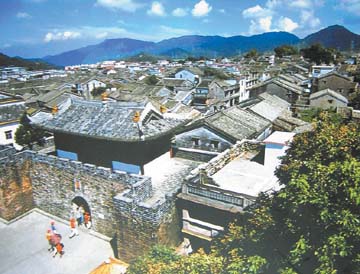CHINA has plenty of places where revolution is commemorated, such as Jinggangshan Mountain in Jiangxi Province and Yan’an in Shaanxi Province. Actually, as a border coastal city in southern China, Shenzhen also has its share of places which witnessed the upheavel of revolution. Here are some sites selected by the Shenzhen Municipal Culture, Sports and Tourism Administration. 
Dapeng Fortress It is common knowledge that the Opium Wars started in 1840, which was the beginning of China’s modern history, but actually, the first fire between the Chinese and British armies was shot at sea outside the Dapeng Ancient Town in 1839, said Weng Songling, president of the Dapeng Ancient Town Museum. Established in 1394, Dapeng Fortress has been an important military defense since the Ming Dynasty (1368-1644), playing a key role in combating invaders from Japan, Portugal and Britain. On Sept. 4, 1893, the British army started a fight outside the town and General Lai Enjue commanded the army from the Qing Dynasty (1644 -1912) to victory in what was called the “Kowloon Sea Battle.” At present, the former residential house of Lai in the town still remained the same as in old times. Add: Pengcheng Community, Dapeng Subdistrict, Longgang District (龙岗区大鹏街道鹏城社区) Buses: 360, 364 (Dapeng stop), transfer to bus 818 (Hedian stop) Gengzi Uprising Memorial Hall Not many people know that the first uprising initiated by Sun Yat-sen was in Shenzhen a few years before the Revolution of 1911. In 1895, Lu Haodong was killed in Guangzhou after a failed uprising and was called “the first martyr for the republic.” Many people thought the first uprising was in Guangzhou. However, Lu’s uprising failed due to betrayers and the battle itself was averted by the government. In 1900, Sun sent Zheng Shiling to Sanzhoutian to start another uprising and it was later changed to Maluan Mountain. More than 2,000 people joined in the uprising and it eventually failed 20 days later. The uprising is remembered as “Gengzi First Uprising.” “Sangzhoutian and Maluan Mountain were all in Shenzhen and the uprising fired the first shot to bring down the Qing Dynasty,” said Song Xin, president of the Gengzi Uprising Museum. Sun also spoke highly about the uprising, emphasizing its significance to the Revolution of 1911. Located in OCT East in Yantian District, the museum has now become one of the most famous revolutionary tourist attractions. Lu’s house in Maluan Mountain, which was the command headquarters of the uprising, is located in Pingshan New Zone and well-preserved. Add: OCT East, Dameisha, Yantian District (盐田区大梅沙东部华侨城) Buses: 53, 103, 103B, 237, 308, 242, J (Dongbu Huaqiaocheng stop) (Wang Yuanyuan) | 
